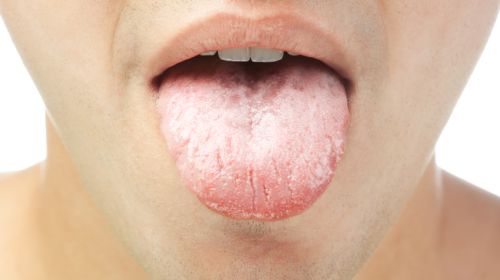Author: Monika Preuk, medical writer
Last update:
December 07, 2020
A sore throat is one of the main signs of a cold. But sometimes the pain becomes very intense and radiates into the ear. Then a Seitenangangina could be behind it. Those who run out of almonds are particularly at risk.
- A massive sore throat that extends below the ears is the most important symptom of a lateral cord angina. It is triggered by viruses or bacteria such as pneumococci and staphylococci.
- © iStock.com/gilaxia
The cold is actually already over. But then the sore throat becomes more severe and the feeling of sickness increases again. The cause: a lateral cord angina, medically angina lateralis. The so-called side strands are inflamed. These are lymph vessels that run from top to bottom on both sides of the throat.
At a glance:
Fighting a sore throat: Get rid of the scratching with these home remedies
Lifeline / week
What is a side strand angina?
A lateral cord angina can only appear on the left or right side of the throat, and sometimes both sides of the neck are affected. Unlike conventional angina, i.e. an inflammation of the tonsils, the lateral cord angina is relatively rare.
The lateral cord angina usually occurs after a cold because then the local defenses of the pharynx are weakened and pathogens find good conditions. The germs settle and multiply. Often these are cold viruses. If the mucous membrane is further stressed as a result, bacteria such as pneumococci or staphylococci often settle in.
There is a particularly high risk of lateral cord angina if the tonsils have been removed, as the protective function of the tonsils is lost. Therefore, a side cordangina mainly affects adults and rarely children. Because children, in contrast to adults, usually still have their tonsils (tonsils).
Symptoms of the lateral cord angina at a glance
The symptoms of a side cord angina are extremely uncomfortable and include:
Sore throat that is often concentrated in one side and can get very severe
Sore throat that goes up to the ear
difficulties swallowing
general feeling of illness with weakness and exhaustion
high fever (may or may not occur)
a headache
pressure-sensitive lymph nodes below the ear
Diagnosis of the lateral cord angina
You should see a doctor, especially if you have a fever, the sore throat is severe and you feel very exhausted. By means of visual diagnosis when examining the throat, the doctor can already tell whether there is a lateral cord angina. The typical signs: The throat is very red and swollen on the sides. Sometimes yellow dots and whitish-yellow deposits have also formed. The coatings can also affect the tongue.
In addition, the doctor palpates the lymph nodes below the jaw and on each side of the neck. If they are swollen and tender, this is another symptom of the lateral cord angina. With a throat swab, he can also determine which pathogens are present.
Lateral cord angina: treatment and complications
Treatment of the lateral cord angina depends on its severity. For a mild form without fever, home remedies are sufficient such as lozenges or gargle solutions to heal the inflamed mucous membrane of the throat. If, on the other hand, the lateral cord angina is very pronounced and bacteria have multiplied rapidly, more intensive therapies are required. If the lateral cord angina is not treated properly in this case, there is a risk of complications such as
The side strand angina is not a harmless infection that can simply be ignored – even if it is a mild form. If you have a side strand angina, be sure to stay at home for a few days, preferably in bed. Get plenty of sleep and don't make too much effort. With the help of a few home remedies, the sore throat usually heals on its own.
When antibiotics are useful for lateral cord angina
However, a side cord angina is not always free of complications. If the measures and home remedies listed above did not bring any improvement after six days, doctors usually used to prescribe an antibiotic. Today, many doctors are starting to use a rapid test to check whether bacteria are actually the cause of the lateral cord angina and then, if necessary, to prescribe the appropriate antibiotic. Because antibiotics only work against bacteria, not against viruses, which are also often the cause of sore throat.
If it is bacteria, penicillin is the drug of choice. However, there are bacterial strains that have already become resistant to this active ingredient. In this case, cephalosporins or macrolide antibiotics offer an alternative. The same applies to treatment with any other antibiotic: Follow your doctor's instructions strictly and do not stop treatment prematurely, even if you are already feeling better.
These home remedies will help with side strand angina
In addition to the generally accepted home remedies, there are also some that have proven themselves especially for Seitenstrangangina:
Sage tea: Drink three to five cups of warm sage tea throughout the day and gargle with it. Sage has a disinfectant effect and thus fights the bacteria in the throat.
Salt water: Gargle with lukewarm salt water. This supports the self-cleaning of the mucous membranes, promotes their blood circulation and makes them strong against pathogens.
Warmth Quark wrap: Heat 500 grams of quark and spread it on a piece of cotton, such as a towel, as thick as a finger. Wrap it around your neck, making sure that the warm curd is right on the sore sides of your neck. Leave the wrap on until the curd becomes dry. Quark can relieve inflammation locally.
The duration of the side cordangina varies greatly
In the majority of those affected, a lateral cord angina is over after one to two weeks. When treated with antibiotics, the symptoms often disappear much faster. This is different with a chronic side cord angina, which is extremely rare. Here the symptoms are not quite as pronounced, but the disease often lasts for weeks and occurs again as soon as the immune system is weakened.
In addition to the sore throat and swollen side cords, a dry, irritating cough is typical of the chronic lateral cord angina. The chronic lateral cord angina can also be healed over time. However, all additional irritant factors, such as smoking and dry air, must be switched off.
Is Seitenstrangangina Contagious?
Regardless of whether the lateral cord angina was triggered by viruses, bacteria or both – there is always a risk of infection. The first symptoms can appear one to four days after contact with a sick person (incubation period).
The pathogens are transmitted by droplet infection, i.e. via the saliva when coughing, speaking and sneezing. You should therefore absolutely avoid using the same cutlery or crockery with a sick person. There is a risk of infection during the entire duration of the illness. However, if the lateral cord angina is treated with antibiotics, the sick person is usually no longer infectious after two days.
If you've overcome a side-strand angina, you won't be immune to the condition in the future. Both the virus families and the bacterial strains that cause the painful throat inflammation come in many varieties. However, the body only ever develops immunity against the pathogen that it has overcome. Therefore, another member of the large family of pathogens can hit him again unprotected and trigger a side cord angina.
Sport despite Seitenstrangangina?
Of course, you shouldn't put additional strain on the body with this disease, for example through exercise. You should therefore refrain from physical activity and take this training break for a few days after you have recovered. If the lateral cord angina was particularly difficult, you should even wait three more weeks until you slowly exercise your strength again. Resuming exercise prematurely could result in setback.
However, it is different with walks in the fresh air. If you are free of fever, nothing stands in the way of getting some fresh air. On the contrary: it activates the immune system and lowers the pathogen load. However, make sure that you are properly dressed, that you do not sweat or freeze.
Lateral strand angina in pregnancy: what home remedies are allowed?
The immune system is particularly challenged during pregnancy. Therefore, the risk of diseases such as a lateral cord angina is slightly increased. Pregnant women who are dealing with this sore throat should definitely see a doctor. With a smear, the doctor can clarify which pathogens are involved.
Only if this is really unavoidable will he prescribe an antibiotic for treatment that does not burden the child and mother. In all other cases, home remedies such as gargling and neck wraps and bed rest are sufficient. However, under no circumstances should you take any medication on your own, but discuss everything with your doctor beforehand.
How to prevent a side strand angina
Strong defenses also keep the sore throat away. Therefore, pay attention to a diet rich in vitamins, get enough sleep, do not smoke and reduce your alcohol consumption. Don't forget that stress also weakens the immune system. Stress management is therefore important for a strong immune system. And: if possible, always breathe in through your nose, not through your mouth. The nose filters pathogens in the lateral cord angina from the air.


